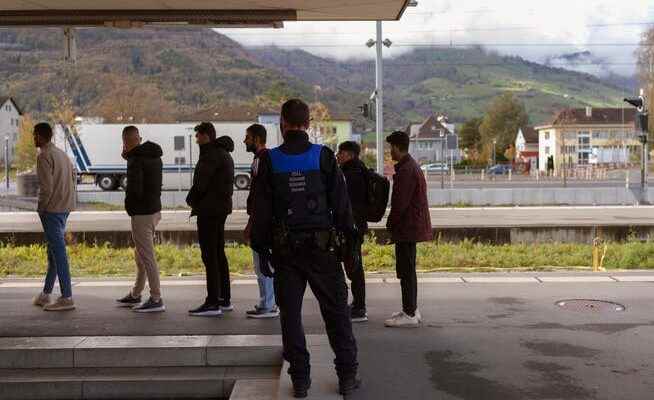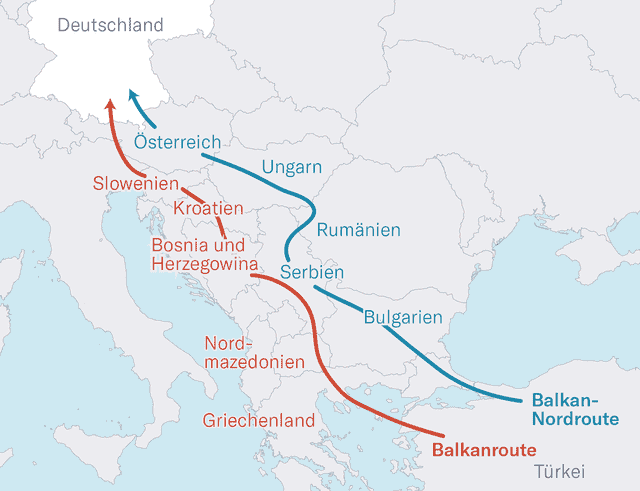Federal Councilor Karin Keller-Sutter and German Interior Minister Nancy Faeser have decided on an action plan. This is intended to stop illegal immigration into the Schengen area.
The border guard checks migrants at the border crossing in Buchs in the canton of St. Gallen.
More than 17,000 migrants have entered eastern Switzerland illegally since the beginning of the year. You take advantage of the freedom to travel in the Schengen area and want to continue to other countries. After the criticism of Switzerland from the German side became louder and louder, the two countries have now joined forces and adopted an action plan to combat irregular migration. For this purpose, Karin Keller-Sutter, the head of the Justice Department, visited the German Interior Minister Nancy Faeser in Berlin on Tuesday. Both countries want to take cross-border action against people smuggling and consistently carry out returns.
In October alone there were almost 7,900 illegal stays in Switzerland, said Keller-Sutter. The number of asylum applications has increased by 55 percent compared to the previous year. Mobility has increased significantly since the end of the pandemic, and the various escape routes are being used again. A large part of the asylum seekers is not in need of protection. For them, Switzerland is not attractive because the country quickly rejects them and deports them so that they don’t overload the asylum system.
Those who come to Germany usually stay
In Germany it is different. The repatriation rate is much higher in Switzerland than in Germany, partly because the country has signed agreements with more countries. Switzerland continued to repatriate during the corona pandemic, unlike many other countries. According to Faeser, Germany is now in the process of concluding similar agreements. At the moment, however, there is a high probability that someone who has reached Germany will actually stay there, even if their application has been rejected. Many rely on that.
“It is important that every country does its homework. But irregular migration cannot be effectively combated alone; international coordination and agreements between neighbors are needed,” said Keller-Sutter. That is why we decided on this action plan. Actually, however, more is needed: a uniform European approach. So far, individual countries have signed repatriation agreements with individual other countries. For example, some countries could return to Morocco well, others just not: “If you could conclude readmission agreements throughout the Schengen area, you would have a much more effective lever,” said Keller-Sutter.
The German Minister of the Interior, Faeser, added that although the borders between Germany and Switzerland would be open for citizens and trade, the aim was to get migration movements under control. “We want to avoid serious measures such as the temporary reintroduction of border controls,” said Faeser. “With our joint action plan, we are therefore taking measures with which we can advance registration and repatriation in particular.”
The migrants often come from Austria and are therefore already in the Schengen area. In principle, Switzerland would have to send them back to Austria, as provided for in the Dublin Agreement – but only if an asylum application is made. However, this does not happen, since most of the arrivals do not want to stay in Switzerland but travel on quickly. The migrants often entered the country via Serbia without a visa. “We formally allow onward travel,” said Florian Schneider from the St. Gallen cantonal police of “NZZ am Sonntag” at the end of October.
This policy angered Germany. The German Federal Office for Migration and Refugees even accused Switzerland of not acting in accordance with the Dublin Agreement. Criticism also came from the Union faction in the German Bundestag: by waving through, Switzerland was allowing illegal entry into Germany and was not fulfilling its obligations as a member of the Schengen area.
The criticism is probably so sharp in tone because the dimension of the problem has become bigger and bigger. Thousands of migrants have arrived in Switzerland and Germany via the Western Balkan route and the central Mediterranean route in recent months. Many of these people travel through other Schengen countries or have already applied for asylum elsewhere.

